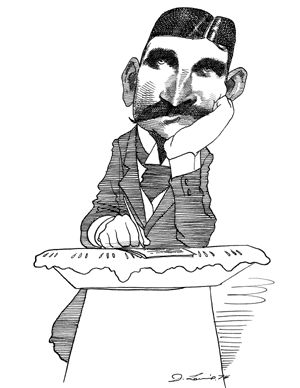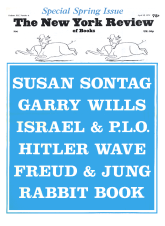For more than half a century after L. Frank Baum discovered it in 1900, the Land of Oz had a curious reputation. American children by the thousands went there happily every year, but authorities in the field of juvenile literature, like suspicious and conservative travel agents, refused to recommend it or even to handle tickets. Librarians would not buy the Oz books, schoolteachers would not let you write reports on them, and the best-known history of children’s books made no reference to their existence.
In the past few years, however, Oz has at last been discovered by grownups. The books are beginning to make their way into public libraries; serious critical articles on them have started to appear, and a cult of collectors and enthusiasts is growing up. There is now an International Wizard of Oz Club with headquarters in Kinderhook, Illinois—a place which I assume really exists, though Baum might well have invented the name himself.
The tremendous success of the Oz books with American children, and their long failure to please conservative adults, are probably related. The Wizard of Oz represented a sharp break with the European nineteenth-century tradition of children’s fantasy, both in style and content. This was quite deliberate on Baum’s part. In his introduction he declared his wish to write “a modernized fairy tale” in which “the stereotyped genie, dwarf, and fairy are eliminated.”
Both the characters and the setting of The Wizard of Oz are very American. The Wizard himself, that famous humbug, with his gift for showmanship and publicity, and his lack of real powers, is a well-known American type. Not only does he resemble many of our politicians, past and present, he also recalls the nineteenth-century traveling pitchman and sideshow barker, a type which reached its apotheosis in the impresario P. T. Barnum. (Baum suggests both these connections when he reveals in later volumes that the Wizard’s father was a politician, and that he used to be with “Bailum and Barney’s Circus.”)
Dorothy too is recognizably American, though she has much in common with her most famous predecessor, Lewis Carroll’s Alice. Both are independent, brave, and practical little girls, but Alice, as an upper-middle-class Victorian child, is far more concerned with manners and social status. She worries about the proper way to address a mouse, and is glad she doesn’t have to live in a pokey little house like Mabel. Dorothy already lives in a pokey little house. Demographers would class her among the rural poor, but she takes for granted her equality with everyone she meets.
The supernatural beings in Oz are similarly unconventional. Like the protagonists of many European folk tales, Dorothy is accompanied on her journey by three “magic helpers.” But as the author has forewarned us, they are not the traditional dwarves or enchanted beasts. The Tin Woodman was based on a figure Baum had created himself when he was decorating a hardware-store window in Indiana, Scarecrows stood guard over hundreds of midwestern cornfields, and the Cowardly Lion could be seen any day moping in the Chicago zoo.
The landscape of the Oz books, too, is familiar. Dorothy’s Kansas suggests Aberdeen, South Dakota, where Baum tried unsuccessfully to run a general store and then a weekly newspaper between 1888 and 1891, bad years marked by drought, crop failures, falling farm prices, and a disastrous cyclone: “Not a tree nor a house broke the broad sweep of flat country that reached the edge of the sky in all directions. The sun had baked the plowed land into a gray mass, with little cracks running through it. Even the grass was not green, for the sun had burned the tops of the long blades until they were the same grey color.”
Oz itself can be seen as an idealized version of America in 1900—happily isolated from the rest of the world, underpopulated, and largely rural, with an expanding magic technology and what appear to be unlimited natural resources. The social historian Henry M. Littlefield has recently made the identification more explicit. He remarks that Baum divided Oz into four countries, of which two, the Gillikin Country in the North and the Quadling Country in the South, are ruled by good witches when Dorothy arrives—perhaps reflecting Baum’s conscious or unconscious belief that middle America was in fairly good shape. The Munchkins in the East, on the other hand, are ruled by a Wicked Witch who has transformed the originally human Woodman into a mechanical man who feels as if he has no heart—possibly a comment on the increasing industrialization and dehumanization of the eastern United States.
As for the largely unsettled Winkie Country in the West, it is also dominated by a Wicked Witch, who threatens Dorothy and her friends with natural rather than mechanical dangers. Her attacking forces of wolves, crows, and bees may represent the threat to early settlers and farmers from wild animals, birds, and insects which destroyed crops; and her Winged Monkeys, according to Mr. Littlefield, are Plains Indians. He goes on to interpret The Wizard of Oz as a deliberate allegory of the Populist movement, in which the Wizard himself is William Jennings Bryan.
Advertisement
But as Michael Patrick Hearn maintains in his introduction, to limit the book in this way is a mistake. The Wizard of Oz is not a simple allegory with only one correct explanation, but a “symbolic narrative” which can operate on many levels, and always remains open to new interpretations. The Land of Oz can be, and has been, seen not only as a metaphor of turn-of-the-century America but as a Freudian dream world, a socialist utopia, and a spiritualist vision. Baum and his wife, like many of their contemporaries, were interested in spiritualism, and held séances in their parlor in North Dakota. The socialist interpretation has less foundation in Baum’s life, but it has continued to be taken seriously in some circles—in 1961, according to Mr. Hearn, a Los Angeles newspaper called Baum a communist.
To my own mind, the lush semitropical vegetation and whimsical architecture of Oz have always suggested Southern California, where Baum spent his final years. This identification is surely behind the 1939 MGM film of The Wizard of Oz, starring Judy Garland. Here the technicolor Land of Oz is the dream vision of a Depression farm girl, full of huge artificial-looking flowers and instant stucco castles. The center of this land is Los Angeles, and specifically Hollywood. To get there, you “follow the yellow brick road,” which is not yellow in the film, but golden—quite naturally, because it is made of money. The road leads to a walled city with considerable resemblance to the old MGM studios. Within there is a movie magnate’s throne room and sound stage, where Oz manufactures his electronic illusions.
Oz, like Louis B. Mayer, has no real magic powers, so he cannot grant the wishes of Dorothy and her three companions—who in the film are also from Kansas, and are Uncle Henry’s farmhands. Oz cannot really give the Scarecrow a brain and the Tin Woodman a heart, or make the Cowardly Lion brave, since these qualities—intelligence, love, and courage—are not available in Hollywood. But he can pretend to do so, which is all that is necessary. As representative middle Americans, Dorothy’s friends already have the qualities they are seeking. What they lack is faith in themselves, and Oz (metaphorically, MGM) can give them that—so his magic is real after all. Thus the film The Wizard of Oz is simultaneously an exposure, a defense, and a successful example of the role of Hollywood in American life at the time it was made.
The Annotated Wizard of Oz is another complex and lavish production, a handsome technicolor book the size of a small tea-tray. It includes not only a facsimile of the first edition but reproductions of related posters, maps, and previously unpublished illustrations, plus a great many interesting photographs. The introduction is informative, though rather heavily weighted on the bibliographical side, and tells more than you may care to know about the publishing history of the Oz books.
As for the notes themselves, they vary from fascinating to far-fetched. Baum’s text is not very difficult, and Mr. Hearn sometimes appears to be straining to find matter for annotation. It is interesting to learn that Dorothy’s cyclone was technically a tornado, but a description of the Wizard’s personality in terms of R. D. Laing’s theories seems beside the point, and would surely puzzle any child who came across it. But of course this volume is not intended for children, or for those unfortunate adults who have never traveled in Oz. If you have already been there, however, and wish to go again, The Annotated Wizard of Oz is an excellent guidebook to its history, geography, inhabitants, and customs.
This Issue
April 18, 1974




